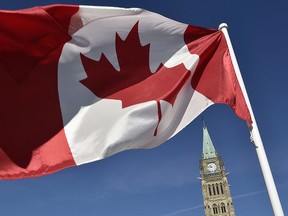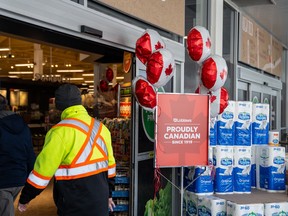Canada needs to update its food system to become more resilient in a changing world
Article content
With many lower mainland communities on the verge of being cut off by mudslides and floods, people everywhere should be asking “how long could I survive if my neighbourhood, my grocery store, or my city stops receiving its daily food supply from other parts of the world?”
Advertisement
This advertisement has not loaded yet, but your article continues below.
Article content
While it’s difficult to answer this question objectively, many believe that most cities have about three days’ worth of fresh goods. Non-perishable food will last longer, but fresh fruits and vegetables, as well as meats and proteins, would run out fast.
Consequently, it has been said that “civilization is only ever nine meals from anarchy” and it would be wise if we all asked how quickly social order would break down in the face of a major disruption.
Of course, the acute crisis triggered by the storm in southwestern British Columbia is also playing out on a global — albeit slower — stage. The pandemic, climate change and a host of other factors mean the smooth seamless trade we all used to take for granted is now struggling and less reliable.
Advertisement
This advertisement has not loaded yet, but your article continues below.
Article content
Let’s consider food. Most Canadians depend on the so-called industrial food system to produce a vast quantity of relatively cheap nutrition. This system of large farms and long-distance trade has been so successful that both food prices and hunger dropped between the 1980s and the 2010s to historic lows. For most people, this has been a boon.
For this system to operate, oil and other fossil fuels must be cheap, water for irrigation plentiful, and the weather productive. Countries must also let goods and services flow across borders. When these conditions were met, the industrial food system was remarkably successful.
But the world isn’t like this anymore. Trump’s election illustrated that many question the benefits of trade. We now know that the 2050s, 2060s and 2070s will not be as productive as the 1950s, 60s and 70s. If we are looking for a historic analogy as a way of preparing for what’s in store, we should look at the 1930s when the Dust Bowl and Great Depression upended things. In short, the bedrock assumptions on which the industrial food system rest have changed, and so the food system must change as well.
Advertisement
This advertisement has not loaded yet, but your article continues below.
Article content
Here are two ideas to help put Canadians ahead of the game, protect our citizens, and demonstrate we are both climate resilient and a world-leader.

First, let’s stop importing fruits and vegetables from places like California. We are pretty certain that California will be too dry to be the world’s fruit basket in a generation and relying on daily shipments crossing international borders is both unsustainable and un-resilient. We should adopt policies like those found in Singapore, where the government has pledged to be 30 per cent self-sufficient by 2030. Of course, Canada isn’t Singapore and as a nation we should continue to export as much food as we can. But for fruits and vegetables, we need to be more sovereign. If Singapore can do it on practically no land, then surely Canada can. Achieving this requires a multi-pronged strategy that includes more of us eating seasonally and investing in food storage and food processing facilities. Being sovereign in fruits and vegetables will also mean building more vertical farms and greenhouses that produce locally and year-round. If we do this, we can save land, reduce carbon emissions and boost self-sufficiency.
Advertisement
This advertisement has not loaded yet, but your article continues below.
Article content
-

Storm of the century cuts off traffic to Canada’s biggest port in latest hit to supply chain
-

Global food prices to stay high next year on labour crunch, Cargill CEO warns
-

‘That’s too much’: Highest price hike to milk in recent memory sparks criticism of supply management
-

Next cabinet needs to get serious about food, agriculture leaders say
The second big idea is to turn agriculture from being a source of greenhouse gas emissions into a carbon sink. Today, agriculture and food systems contribute a whopping one third of greenhouse gas emissions. This is crazy. Plants absorb carbon dioxide as they grow, and well-managed soils can store carbon dioxide as organic carbon. Building up the soils’ organic carbon can both reduce climate change and help farmers withstand extreme weather as high organic carbon soils perform better during droughts and are less vulnerable to floods. Turning agriculture from a source of the climate problem to a key part of the solution also demands a multi-pronged strategy. First, farmers must embrace “regenerative agricultural practices” such as reducing tillage, planting winter cover crops and using more complex crop rotations as these practices increase the soil’s organic matter. Second, governments need to step in and provide financial incentives to help farmers make this shift.
Advertisement
This advertisement has not loaded yet, but your article continues below.
Article content
This year, Mother Nature started to play for keeps and the terrible storms and heat domes affecting British Columbia should be seen as a wake-up call. The systems we all rely on for our daily survival were built during a period when the underlying environmental and economic conditions were fundamentally different than they are now. Just as the world is changing, we need to change our food systems. The question is do we have the courage and political will to build the kinds of systems fit for the challenges of the next generation?
Evan Fraser is the director of the Arrell Food Institute at the University of Guelph.
Advertisement
This advertisement has not loaded yet, but your article continues below.
Evan Fraser: B.C. storms a reminder that our food supply system leaves us ‘nine meals from anarchy’
2021-11-17 20:01:03






